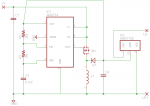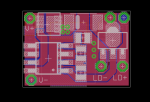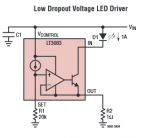rhd
0
- Joined
- Dec 7, 2010
- Messages
- 8,475
- Points
- 0
Inverting buck / boost drivers have always hurt my head, but as I think about it, I'm starting to wonder whether this variant if switching driver may actually be the solution for case positive diodes.

The V- essentially becomes continuous with the LD+, even though technically they're never part of the same closed circuit. Out seems to me that you could have the LD+ attached to the host, and the host would actually be tailcap negative (which sounds strange, I realize).
What am I missing? Wouldn't this work?

The V- essentially becomes continuous with the LD+, even though technically they're never part of the same closed circuit. Out seems to me that you could have the LD+ attached to the host, and the host would actually be tailcap negative (which sounds strange, I realize).
What am I missing? Wouldn't this work?
Last edited:










